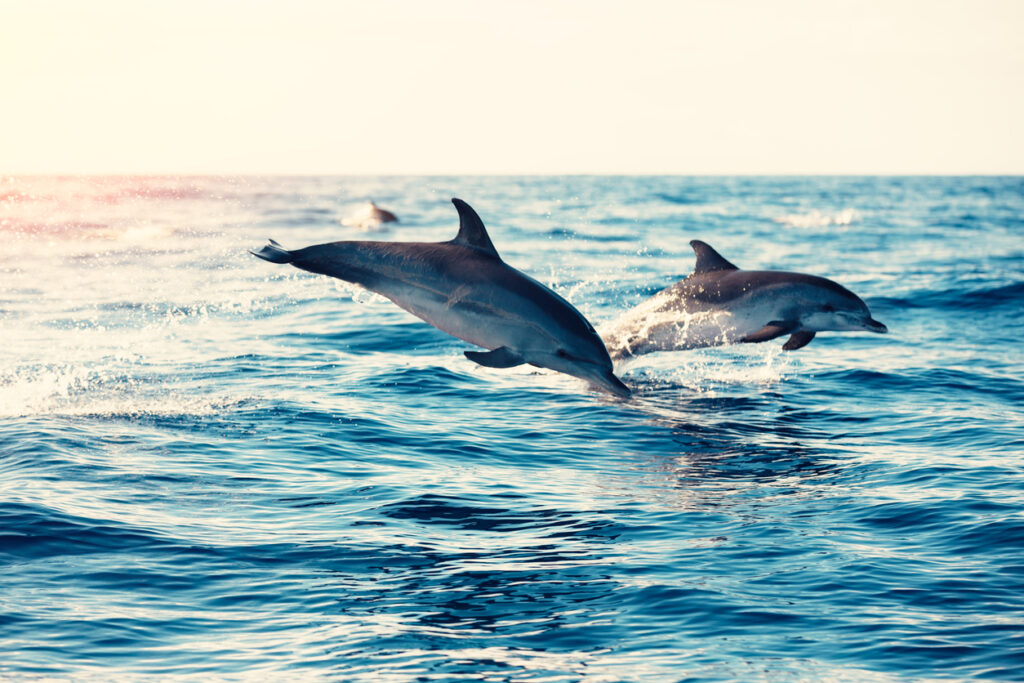In many ways, bees are incredible. Without their efforts, plants would go unpollinated and countless animals and humans would die. They have become the go-to example for hard work – we even talk about ‘worker’ bees, who work from sunrise to sunset. Modelling a workforce on bees, however, leads to burnout, stress and a work/life balance where all the weight is on work. In short, many of the problems associated with the contemporary workplace.
The life of a dolphin is definitely more appealing than the life of a worker bee. The experience of the dolphin can teach us a lot about flexibility.
If we want to tackle these problems head on, we need to look for alternative models of working. What better model could there be than the dolphin? A creature so intelligent that it has been recognised as a ‘non-human person’ in several countries and noted for its altruism, teamwork and sense of fun.
Read on for four ways that HR professionals can encourage the teams of the future to be more dolphin and less worker bee.
1. Central workplace versus remote communication
For bees, everything centres around the hive. Worker bees only leave to collect pollen, from which they make honey to feed the colony over the cooler months. In this way, the hive can be seen as comparable to a central workplace, where everyone is required to cluster to do their work.
Although bees may be content to work like this, modern workers are not. Remote working is on the rise: in the US, for example, it increased by 159% between 2005 and 2017. This has been driven largely by developments in technology that enable remote work and by millennial workers who prize flexible working.
Many workplace analysts speculate that this shift will be accelerated by the coronavirus outbreak, which is forcing millions of people to work from home. Even after the pandemic there may be a permanent move to more remote work.
While working remotely, it is vital that teams continue to communicate. In this we can learn from dolphins. Dolphins typically live and travel in pods of around five to 20 members, but they spread out when they swim, making sure that they do not lose each other by constantly communicating through high-pitched whistles which they can hear more than 20 km away.
What HR can do:
With the move to remote working showing no signs of abating, managers should learn how to supervise remote teams. Like dolphins, they need to be able to know where the other members of the team are and what they are doing, without curtailing the freedom that employees are looking for in remote work. It is important to ensure that managers have proper training in leading remote teams, while workers know what is expected of them when working remotely.
2. Same old versus innovation
Nobody can deny that bees are incredibly productive: during one season an average colony will produce 90kg of honey by visiting 500 million flowers. Unfortunately, this productivity has its limitations. Bees have been doing the same things for millions of years, and that’s great if your employees need to keep churning out the same stuff, day in and day out. Most modern workforces, however, require some aspect of creativity or innovation. They need to be more like dolphins.
While worker bees might seem like the model workforce, the reality is that their entire existence is based on working for the good of the colony. In human workers this is an impossible standard.
Dolphins have the ability to innovate and learn new skills – so much so that the US Navy uses dolphins to find underwater mines as they are better at it than machines. Meanwhile in the wild, some dolphins off the coast of Australia use sponges to help them hunt, a relatively recent innovation from the last 200 years.
What HR can do:
If the workforces of the future want to continue to adapt to a changing world, they will need to take inspiration from dolphins by learning new skills. HR can help employees to adapt and grow by ensuring that they have opportunities for development. The millennial workforce in particular wants to develop new skills through their career – one of their main reasons for leaving a job is the lack of leadership training opportunities.
Consider making some of your training available digitally so they can access it whenever they want to, and as a bonus this sort of training is more accessible for your remote workers as well.
3. Live to work versus flexibility
During the summer, a worker bee lives a mere 42 days. They live to work – everything they do is for the overall good of the colony. Dolphins can live until they are in their 60s, so they spend a lot more time doing things just because they are fun, from jumping along in a boat’s wake to throwing a pufferfish to each other to get high. While we don’t advocate getting stoned at work, the life of a dolphin is definitely more appealing than the life of a worker bee. The experience of the dolphin can teach us a lot about flexibility.
Work/life balance is one of the most important things to employees nowadays, and with good reason. As the animal kingdom shows us, living to work is only possible for a short amount of time. In our long lives, we need to make time for other things. The best way of giving people work/life balance is by allowing them to work flexibly and measure output rather than the number of hours spent at a desk.
What HR can do:
Different organisations are at very different stages regarding flexible working. In some organisations where flexible working is not widely practised, HR can play a key role in advocating for it and extolling its many benefits. In organisations where flexible working is further along, it is important to make sure that clear policies are in place so staff know where they stand.
[cm_form form_id=’cm_65a14c3f5da64′]
While worker bees might seem like the model workforce, the reality is that their entire existence is based on working for the good of the colony. In human workers this is an impossible standard. If we want to successfully nurture the teams of tomorrow we should remember to treat them more like dolphins – or in other words, like individuals, creating policies that can adapt to suit people, rather than demanding it be the other way round.
Interested in this topic? Read The human-focused workplace: how to redesign your organisation to achieve people-centricity.






